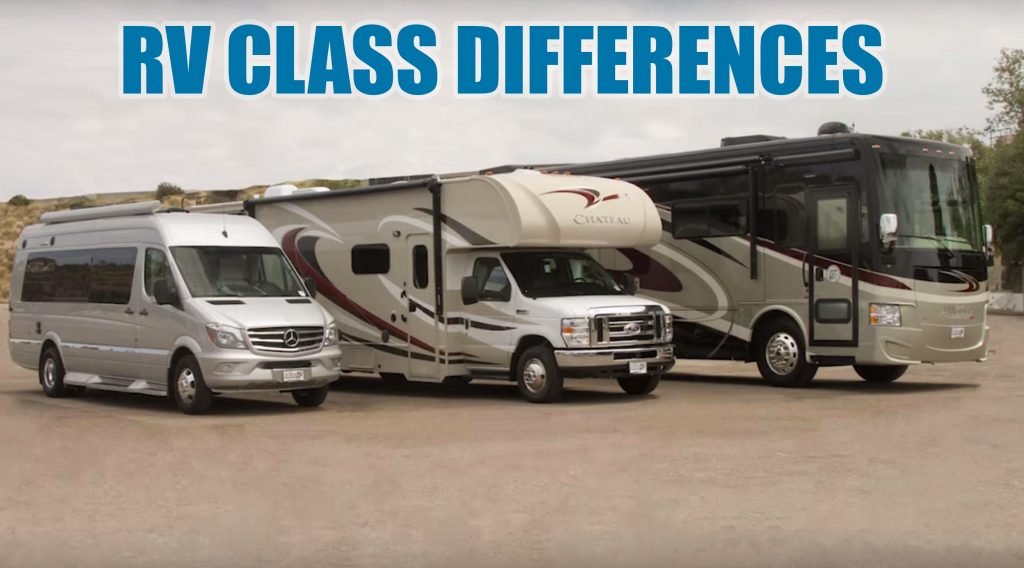The different RV Classes – A Class, B Class, and C Class
To the untrained eye or when discussing motorhomes with friends one might not always know of or understand the differences in RV classes. There are three classes of motorhomes, and through this article we will teach the reader how to easily spot the differences and provide a detailed list as to how to select the right RV for your needs. The first step to making your selection is to understand the differences between the three classes.

Class A Motorhomes
The first thing to know about class A motorhomes is that they are ideal for large families and individuals who intend to use their motorhome as a primary home (i.e. for sleeping and working). Due to their large size and target audience, class A motorhomes are the most expensive class on the market. They are usually between 20% – 50% more expensive than a class B or C motorhome.
Class A motorhomes are large, usually starting around 24 feet in length, and tend to stick to a rectangular shape. These vehicles come equipped with a large bed space, a living space, and a hefty amount of storage. Because of this convenient and expansive design, RVers can enjoy productive and comfortable working while in the vehicle. Class A motorhomes also sit the highest on the road, come standard with tall and extended windows, and offer a beautiful panoramic view of the scenery when driving through the mountains. Also, if you are around 6 feet or taller, the A class motorhomes will be your only shot of not hitting your head daily on the doorways or ceiling.
The A class motorhome is a great option for families or individuals who plan to spend an extended time in their vehicle or who enjoy the added luxury.
Class B Motorhomes
What drives most consumers to purchasing a Class B motorhomes is the affordable gas mileage. In most cases, the class B RV will have the best gas mileage compared to both a class A and class B RV. The main drawback to the gas mileage is the overall size of the class B motorhome.
A class B RV is the most compact of the three designs, often resembling that of a full sized van with a slightly raised ceiling. Most people say that these are just large vans, and they would be correct considering the majority of class B motorhome manufacturers use prefabricated van chassis. This means that they will be slightly longer than a standard full sized van, but still built off of the same frame. Their compact design offers minimal space for the luxuries associated with the class A vehicles.
Another overlooked benefit of a class B is the rear towing hitch, which can be used to haul trailers, boats, or vehicles.
The class B motorhome is an excellent starting RV due to the similarity to a standard car or full sized van. Passengers ride in the back, and the RV comes equipped with standard safety belts, turn signals, high beams, radio, and other standard features found in cars.
If you are looking for a start RV and are looking to accommodate 3-4 people maximum, then a class B RV may be a great starting point.
Class C Motorhomes
A class C RV is a good stepping stone between a Class B and C motorhomes. The main feature of a class C motorhome is the sleeping area located directly over the driver cockpit. These are slightly larger than class B RVs in terms of height as well as length offering a middleground between a class A and a standard car.
This is by far the top selling motorhome class, offering a balance between storage space, living area, and other luxuries such as a bathroom and shower space and capacity. Most RV manufacturers offer multiple interior layouts offering the buyer a choice between larger living space, sleeping space, and bathroom / shower space.
A major drawback to the class C motorhome is the fuel economy that comes with the added size and luxury options. These use a larger chassis than a full size van and a larger motor as well. These are also a smiilar height as a class A motorhome, but usually 30% shorter in length. For this reason, many campgrounds prefer a class C due to the more economical space it takes up on a camping ground, however you may find it difficult to fit into a standard garage.
Conclusion
The most important decision to make before purchasing a motorhome is to understand what your desired uses are. From there ask yourself how many people you will be transporting and what type of luxuries are required. Finally, will this fit at the final destination.